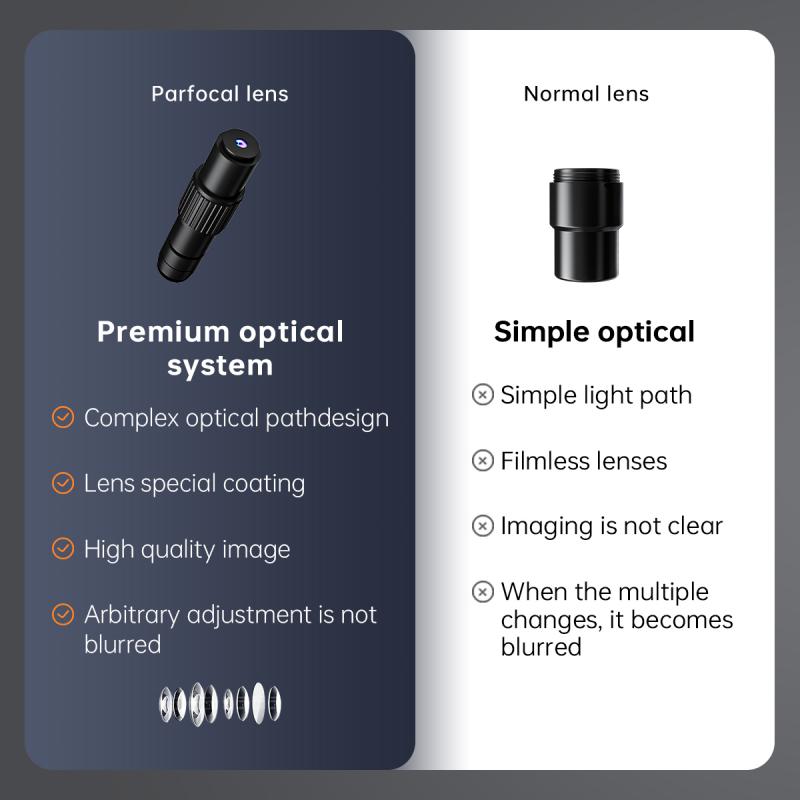What Can You See Through A Microscope ?
Through a microscope, you can see objects that are too small to be seen with the naked eye. This includes cells, microorganisms, bacteria, and other microscopic structures. Microscopes allow for magnification and resolution, enabling scientists to study the intricate details of these tiny objects and observe their behavior, structure, and interactions. Additionally, microscopes are used in various fields such as biology, medicine, chemistry, and materials science to conduct research, make observations, and analyze samples at a microscopic level.
1、 Microorganisms and Bacteria
Through a microscope, one can observe a vast array of microorganisms and bacteria that are otherwise invisible to the naked eye. Microorganisms, also known as microbes, are tiny living organisms that include bacteria, fungi, protozoa, and viruses. These microscopic organisms play a crucial role in various ecosystems and have a significant impact on human health.
When examining samples under a microscope, one can observe the intricate structures and behaviors of microorganisms. Bacteria, for example, can be observed in their various shapes, such as cocci (spherical), bacilli (rod-shaped), or spirilla (spiral-shaped). Additionally, the microscope allows us to observe the movement of microorganisms, such as the flagella-driven motility of bacteria or the cilia-driven movement of certain protozoa.
Furthermore, the microscope enables scientists to study the interactions between microorganisms and their environment. For instance, researchers can observe how bacteria adhere to surfaces, form biofilms, or engage in symbiotic relationships with other organisms. These observations provide valuable insights into the mechanisms of microbial colonization, pathogenesis, and ecological interactions.
In recent years, advancements in microscopy techniques have further expanded our understanding of microorganisms. For example, fluorescence microscopy allows scientists to label specific components of microorganisms with fluorescent dyes, making them easier to visualize. This technique has been instrumental in studying the internal structures of bacteria, such as their DNA, cell walls, and organelles.
Moreover, electron microscopy has revolutionized our ability to observe microorganisms at an even higher resolution. With electron microscopes, scientists can visualize the ultrastructure of microorganisms, revealing intricate details of their cellular components and surface features.
In conclusion, through a microscope, one can see a diverse range of microorganisms and bacteria, gaining insights into their structures, behaviors, and interactions. The latest advancements in microscopy techniques have further enhanced our ability to study these microscopic organisms, leading to new discoveries and a deeper understanding of their roles in various fields, including medicine, ecology, and biotechnology.

2、 Cells and Tissues
Through a microscope, one can observe a vast array of cells and tissues. Cells are the building blocks of life, and their intricate structures and functions can be explored in great detail using this powerful tool. Microscopy allows scientists to study the smallest components of living organisms, providing valuable insights into their behavior and characteristics.
When examining cells under a microscope, one can observe their various organelles, such as the nucleus, mitochondria, and endoplasmic reticulum. These structures play crucial roles in cell metabolism, energy production, and genetic information storage. Additionally, the microscope enables the visualization of cellular processes like mitosis, where cells divide and replicate their DNA.
Tissues, on the other hand, are composed of groups of cells that work together to perform specific functions. Microscopy allows for the examination of different types of tissues, including epithelial, connective, muscle, and nervous tissues. By observing tissues under a microscope, scientists can identify their distinct characteristics, such as cell arrangement, shape, and organization.
Advancements in microscopy techniques have revolutionized our understanding of cells and tissues. For instance, confocal microscopy and electron microscopy have provided higher resolution and 3D imaging capabilities, allowing scientists to delve deeper into cellular structures and interactions. Furthermore, the development of fluorescence microscopy has enabled the visualization of specific molecules within cells, providing insights into their localization and dynamics.
In recent years, advancements in super-resolution microscopy have pushed the boundaries of what can be seen through a microscope. This technique allows scientists to visualize structures at the nanoscale, providing unprecedented detail and revealing previously hidden cellular features. These advancements have greatly contributed to our understanding of cellular processes, disease mechanisms, and the development of new therapeutic approaches.
In conclusion, through a microscope, one can see cells and tissues in intricate detail. The continuous advancements in microscopy techniques have expanded our knowledge of cellular structures and functions, paving the way for groundbreaking discoveries in the field of biology.

3、 Organelles and Cell Structures
Through a microscope, one can observe a wide range of organelles and cell structures that make up the intricate world of cells. These microscopic structures play vital roles in the functioning of cells and provide valuable insights into the complexity of life.
One of the most prominent organelles visible under a microscope is the nucleus. This spherical structure contains the cell's genetic material, DNA, which carries the instructions for cell growth, development, and reproduction. The nucleus is surrounded by a double membrane called the nuclear envelope, which protects the DNA and regulates the movement of molecules in and out of the nucleus.
Another important organelle that can be observed is the mitochondria. These bean-shaped structures are often referred to as the "powerhouses" of the cell because they generate energy in the form of ATP through cellular respiration. Mitochondria have their own DNA and are believed to have originated from ancient bacteria that formed a symbiotic relationship with eukaryotic cells.
Other organelles that can be seen through a microscope include the endoplasmic reticulum, Golgi apparatus, lysosomes, and peroxisomes. The endoplasmic reticulum is a network of membranes involved in protein synthesis and lipid metabolism. The Golgi apparatus is responsible for modifying, sorting, and packaging proteins for transport within or outside the cell. Lysosomes are membrane-bound organelles that contain digestive enzymes and are involved in breaking down waste materials. Peroxisomes are involved in various metabolic processes, including the breakdown of fatty acids.
Advancements in microscopy techniques, such as confocal microscopy and super-resolution microscopy, have allowed scientists to delve even deeper into the world of organelles and cell structures. These techniques provide higher resolution and three-dimensional imaging, enabling the visualization of finer details within cells.
In conclusion, through a microscope, one can see a plethora of organelles and cell structures that contribute to the functioning and complexity of cells. These observations have been instrumental in advancing our understanding of cellular biology and continue to provide new insights into the intricate world of life at the microscopic level.

4、 Microscopic Organisms and Parasites
Through a microscope, one can observe a vast array of microscopic organisms and parasites that are otherwise invisible to the naked eye. These organisms include bacteria, viruses, fungi, protozoa, and various types of parasites.
Bacteria are single-celled microorganisms that can be found virtually everywhere. They come in different shapes and sizes, and a microscope allows us to study their structure, behavior, and interactions with their environment. Viruses, on the other hand, are even smaller than bacteria and can only be seen through an electron microscope. These infectious agents can cause a wide range of diseases in humans, animals, and plants.
Fungi, such as molds and yeasts, are also visible under a microscope. They play important roles in various ecosystems, but some species can also cause infections in humans. Protozoa are single-celled eukaryotic organisms that can be found in water, soil, and the bodies of plants and animals. They are diverse in shape and behavior, and some species can cause diseases like malaria and amoebic dysentery.
Microscopic parasites, including helminths (worms) and arthropods (insects and mites), can also be observed through a microscope. These parasites can infect humans and animals, causing diseases such as malaria, schistosomiasis, and Lyme disease.
It is important to note that the field of microbiology is constantly evolving, and new discoveries are being made regularly. With advancements in microscopy techniques, scientists are now able to observe these microscopic organisms in greater detail, allowing for a deeper understanding of their biology and potential treatments for associated diseases.






































